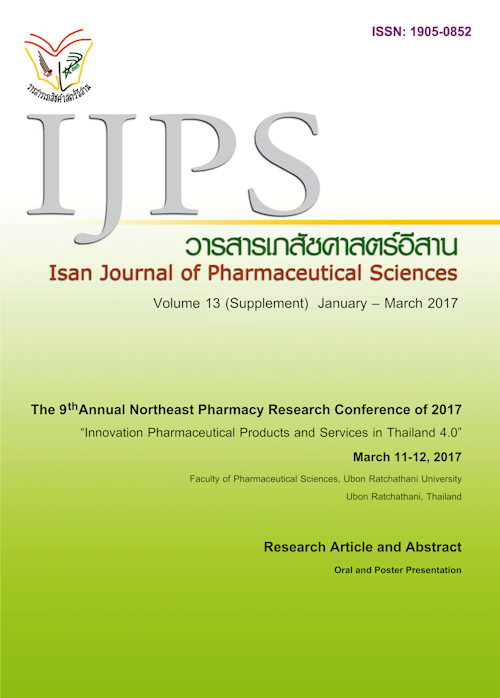Determination of antioxidant, total phenolic compounds and facial cream formulation from Antidesma bunius extract
Main Article Content
Abstract
Introduction: Antidesma bunius (Moa) is a berry group which can find in Northeastern Thailand, ripe Moa fruit is red beyond deep purple which has anthocyanin , numerous total phenolic compounds and antioxidant property. Currently, we are familiar with Moa wine and Moa juice except Moa cosmetics, consequently, the objects of this research are study the result of Moa extract assessment with antioxidant , total phenolic compounds and formulation facial cream. Methods: Five solvents had used for extract including water, 25% ethanol, 50% ethanol, 75% ethanol and 95% ethanol whereat, we got the best extract to formulate five facial creams. After that, before and after the stability test of sensation, chemical and physical by freeze and thaw cycle method about color, odor, viscosity, pH and separate that used the statistic including average, paired sample t-test and one way ANOVA. Results: Moa extracted from 25% and 75% ethanol were the most antioxidant and total phenolic compounds as 6.28 mg/ml (IC50) and 630.01 mg of GA/100 g of extract, respectively, that was significantly (p<0.05). After the stability test found that the fourth formulation from 25% ethanol extract was the best stability that the pH was 5.47 towards the color red, no separation and no change of smell. Conclusion: The study shown that 25% ethanol extract could the best antioxidant activity and bring to formulate facial cream which was expected to develop commercial and variety choice of natural products for customers in the future.
Article Details
In the case that some parts are used by others The author must Confirm that obtaining permission to use some of the original authors. And must attach evidence That the permission has been included
References
Butkhup, L., and Samappito, S. Changes in physic-chemicalproperties, polyphenol compounds and antiradical activity during development and ripening of maoluang (Antidesma buius L. Spreng) Fruits. J Fruit Ornam Plant Res, 2010; 19 (1): 85-99.
Chunthanom P et al. Drying Method for Properties of Meal Moa, RMUTPRes J Special lssue, 2013; (5): 301-307.
Hemar C. et al. Formulation and stability of an oil in water emulsiontaininglecithin, xanthan gum and sunflower oil. Int Food Res, 2001; 20(5): 2173-2181.
Hoffmann, P. Checklist of the GenusAntidesma (Euphorbiaceae) in Thailand. Thai For Bull,2000;28:139-156.
Jorjong S, Butkhup L and Samappito S. Phytochemicals and antioxidant capacities of Mao-Luang (Antidesma bunius L.) cultivars from Northeastern Thailand. J Food Chem, 2015; 181(1): 248-255.
Loipiman P, Phasakul T, and Mongkoltai R. Comparison with antioxidants andtotal phenolic compound of peel fruit. J Sci, 2011; 42(2): 233-236.
Maissuthisakul, P., Suttajit, M., and Pongsawatmanit, R. Assessment of phenolic content and free radical scavenging capacity of some Thai indigenous plants. J Food Chemistry, 2007; 100 (1): 1409-1418.
Musika J and Saehueng U. Effect of Colors and Varieties of Mao Fruits on Physicochemical and Functional Properties. Graduate Res Conference, 2014; 15: 392-400.
Sakulkoo S and Suthum N. Study of Genetic Diversity toMao-Luang (Antidesma bunius L.) with AFLP Method and Comparison of Type and Quantity Antioxidants in Mao-Luang (Antidesma bunius L.) Leafs. J Sci, 2014; 42(1):1-7.
Tiwari, BK., Donnell, CP., Patras, A., Brunton, N., and Cullen, PJ. Anthocyanins and color degradation in ozonated grape juice. J Food and Chem Toxicology, 2009; 47: 2824-2829.


